Cutting thick branches is one of the most challenging aspects of pruning. You’ll need to use the right tree-cutting tool for the branch size you’re looking at to finish the job and avoid any injuries. So, what are the best tools to use for cutting thick branches?
Loppers, pole tree pruners, and pole saws are good for cutting less than 2-inches (5.08 cm) thick branches. If the branches are 3-inches (7.62 cm) thick or more, it may be best to use a hand saw, or a chain saw.
The decision on the cutting tool to use may also be influenced by the position of the branch in relation to your standing position. The rest of this article will cover everything you need to know to help you make the right choice.
Why Cut Tree Branches?
Cutting tree branches can help improve the tree’s overall health. Doing this also helps maintain the landscaping and keeps branches from reaching unwanted parts of the yard without cutting the tree.
When done correctly, the tree quickly seals up the cut part from the inside. The biological reaction helps prevent decay from the cut branch to other parts of the tree. Below are some of the ways cutting tree branches can improve the health of a tree:
- It can keep diseases on affected branches (and the agents responsible) from reaching other parts of the tree.
- Reducing the size of the tree canopy can increase air and sunlight reaching the tree—a good combination to keep out diseases.
- Cutting off weak branches frees up more resources for healthier parts of the tree.
- Keeping branches from getting entwined can ensure healthy and more consistent growth.
Looking beyond tree health, cutting branches can help you prevent damage to your property. Diseased or dead branches can break off in strong winds, causing damage to your property and people passing by.
Tools To Use for Cutting Thick Branches
You can use several tools to cut thick branches, such as a pole tree pruner, gas pole saw, chainsaw, loppers, pruning shears, or a pruning saw. The tools you choose depend on the level of thickness of the thick branches you wish to cut. Keep reading as I further explain these tools and their uses.
Pole Tree Pruner
Keeping your feet on the ground is a good way to ensure you have the right leverage for the job while staying clear of danger when cutting thick branches above your head. A pole tree pruner is a good option to use in this case. A pole tree pruner has a curved head with two blades. The lower blade has to close against the top blade to cut the branch you’re working on.
If you choose to go with this tool, first, you’ll need to understand how it works before deploying it. Take your time to get over the initial learning curve, and you’ll find the process less daunting. A pole tree pruner works best when you’re cutting a branch that’s less than 3 inches (7.62 cm) thick.
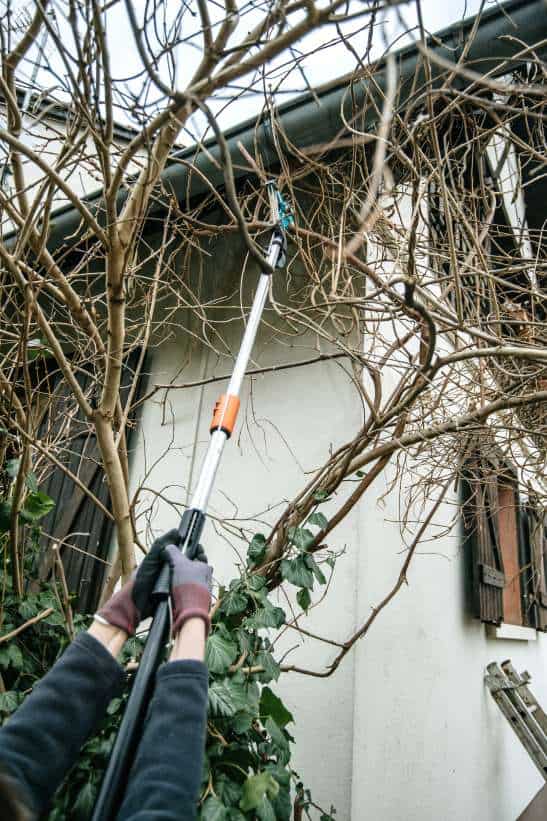
Gas Pole Saw
A gas pole saw is another excellent option for cutting thick branches. With this tool, there’s no need to climb the tree or use a ladder. You can use a gas pole saw for 3-4 inches (7.62-10.16 cm) thick branches. The saw is fitted with serrated blades, ensuring a tighter grip on the wood you’re working on.
You can control the pole saw by moving the entire tool back and forth until you’ve sawn through the wood or by using the attached rope to operate the saw head.
You need considerable upper body strength to use a pole saw because you have to hold the tool over your head for some time. Choose an option with large and sharp teeth to shorten your time holding the tool over your head. Gas pole saws are typically powerful for the job, but you can consider other options as well, such as cordless pole saws or corded electric pole saws.
Chainsaw
If you need to cut a tree branch that’s more than 5-inches (12.7 cm) thick, the chainsaw is your best option for completing the job quickly. Chainsaws come in different sizes, so you’ll need to choose the right size for the job at hand.
Whether you’re faced with a large branch or a medium-sized one, you can find a chain saw fit for purpose. The engine’s size and the cutting chain’s length are the two main metrics to watch for here.
However, before you use a chainsaw to cut thick branches, pay attention to how you intend to reach the branch in relation to the machine’s weight. Even smaller, electric-powered options can weigh up to 20 lbs (9 kg), making them difficult to hold overhead for long periods. You’ll typically need a ladder for branches you can’t climb.
You should keep in mind that gas-powered chainsaws are generally more powerful. Go with them if you want more cutting power.
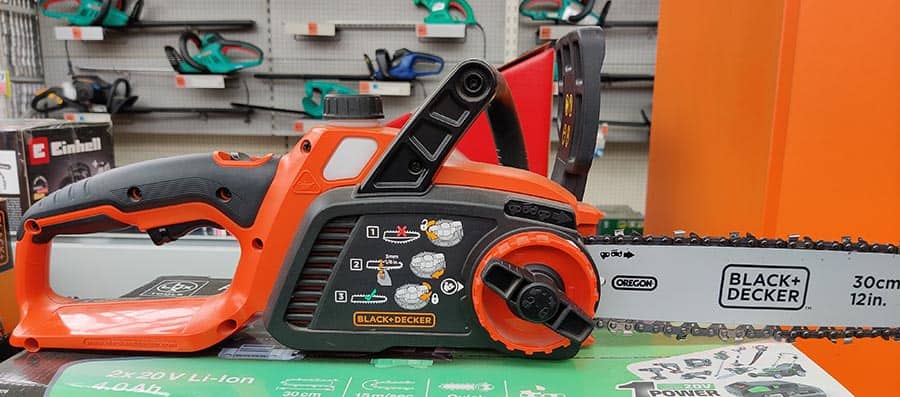
Loppers
For three branches less than 2-inches (5.08 cm) thick, loppers are a great tool to use. They are best suited for handling such branches and twigs. If you have a small tree, you can get loppers and save money on buying costlier gardening equipment.
Loppers are built like your standard scissors but far more powerful. They also have sharper blades on the head of the tool to cut through wood with ease.
Some of them feature additional lever systems or ratchet drives to ensure you have the force you need to cut thicker or healthier branches faster.
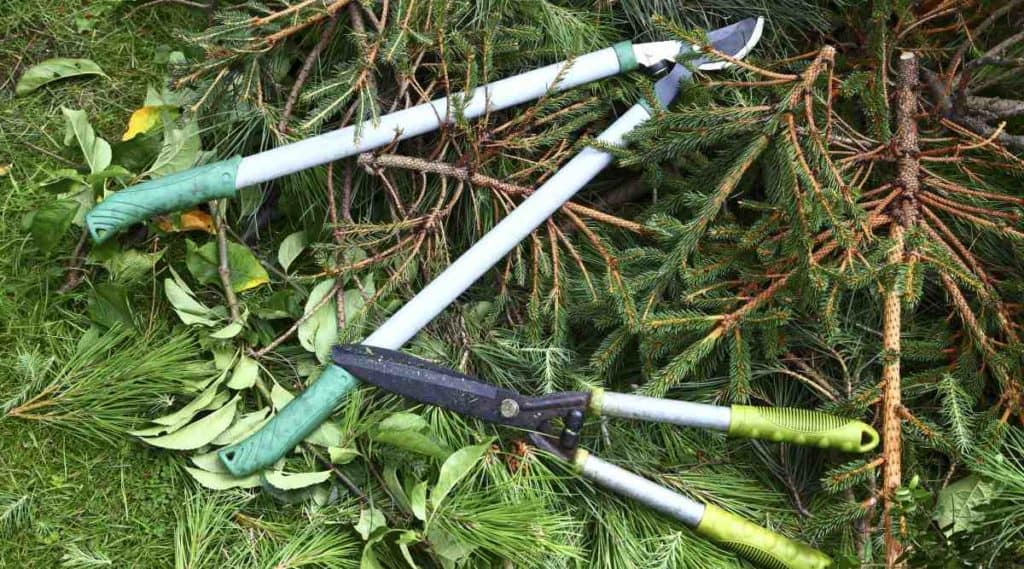
Pruning Shears
Pruning shears or hand pruners are tools for even thinner branches or twigs. You can use one of these when cutting branches that are less than an inch (2.54 cm) thick. They are light and easy to use with just one hand, making them easy to use when you have to climb.
Due to the size of pruning shears, people tend to misjudge how much force they can exert. Pruning shears are powerful enough to cut hard branches up to an inch (2.54 cm) thick.
When choosing your pruning shears, you’ll find options with stainless steel and carbon steel blades. The shears with stainless steel blades are popular because they can withstand corrosion. However, they don’t last long.
On the other hand, the shears with carbon steel blades are more durable, but they are prone to staining and corrosion. Cleaning and oiling the blades after use is the easy way around this problem. Alternatively, you can look for titanium-coated designs which are corrosion resistant and can last a long time.
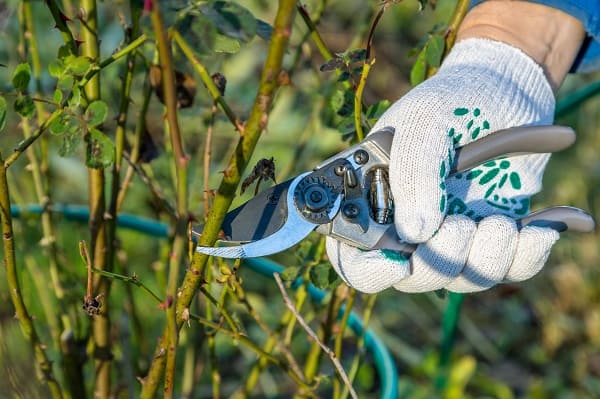
Pruning Saw
Pruning saws can cut branches up to 3-inches (7.62 cm) thick as long as you have the upper body strength needed to get the job done. They are designed like other saws but with a slight curve to maintain placement on the branch while you’re cutting it.
A pruning saw is easy to use, but it can be time-consuming and stressful if you’re working on a tree branch thicker than 3-inches (7.62 cm). There’s also the risk of damaging the saw blade if you use it in a scenario that isn’t ideal.
When buying your pruning saw, you should go with options that will fold down into a sheath when not in use. Such designs ensure you don’t worry about accidents. It also means you can carry the saw up the ladder if you have to work off the ground.
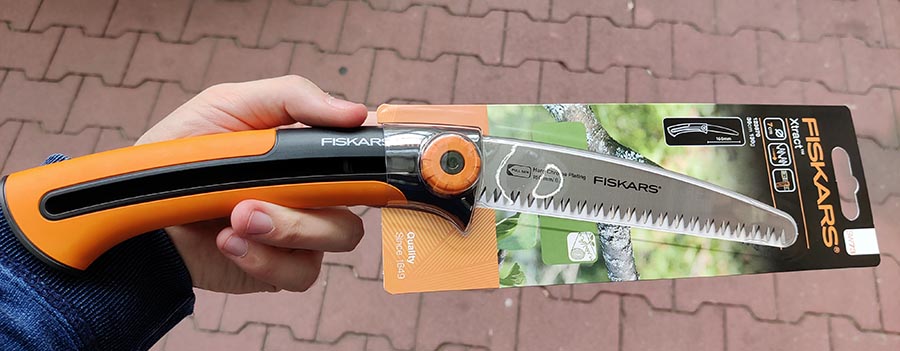
Below is a table that can serve as a quick guide for buying a branch-cutting tool to add to your collection:
| Tool | Recommended Branch Size |
| Pruning Saw | Less than 3 inches (7.62 cm) |
| Loppers | Less than 2 inches (5.08 cm) |
| Chainsaw | More than 5 inches thick (12.7 cm) |
| Gas Pole Saw | 3-4 inches (7.62-10.16 cm) |
| Pole Tree Pruner | Less than 3 inches (7.62 cm) |
| Pruning Shears | Less than an inch thick (2.54 cm) |
Related articles with more information:
- What Is The Difference Between Pruning, Lopping & Trimming?
- What’s the Lightest Corded Pole Hedge Trimmer?
- Your Complete Guide to Pruning Thick Branches
- Complete Guide: How to Prune with a Reciprocating Saw
Tips for Buying Tools for Cutting Branches
Use Telescoping Poles for High Tree Branches
Reaching high up into a tree to cut a tree branch is difficult. Climbing a ladder is an alternative you can work with, but there’s always the chance of falling off the ladder. Most people prefer to keep their feet on the ground for this reason. One way to make sure you can reach higher branches without leaving the ground is to buy tools that include or allow telescoping poles.
You’ll find these poles on smaller chainsaws and pruning saws. They allow you to increase the tool’s reach to work higher up into the tree without any problems. Ensure the tool has a locking mechanism to hold the telescoping pole in place. You don’t want to risk the tool collapsing or falling off while you use it.
Choose Motorized Tools Carefully
Motorized branch cutting tools are typically battery-powered, electric-powered, or gas-powered. While all of them achieve the same purpose, in the end, some are more suited for specific use cases than others.
Battery-Powered Tools
These are the more common, cordless options you’ll find when you buy branch-cutting tools. Battery-powered tools are easier to control as the cordless design ensures more flexibility overall. They are also more lightweight, making them the ideal choice if you regularly have to work overhead.
When choosing a battery-powered tool, consider how long the battery will last on a single charge cycle. With weaker batteries, you may need multiple charge cycles to complete the cutting job.
Using tools with such batteries on multiple tough branches increases the risk of damage as they simply aren’t designed for such heavy-duty tasks.
Ideally, you should only use battery-powered cutting tools if you have a small tree with thin branches and you only need to cut branches once in a long while.
Electric-Powered Tools
Electric-powered tools are a step up from the battery-powered options. They are also lightweight but more powerful. The tools are more reliable, too, because they’ll effortlessly continue to work when connected to a power source.
You also don’t have to worry about noise as most electric-powered tools run quietly. Feel free to use them late in the evening or early in the morning. They are also easy to maintain.
However, just like the battery-powered options, electric-powered cutting tools are only useful for occasional branch pruning. They aren’t the most powerful, so they can’t work for long periods at a time.
Additionally, you need to worry about how to maintain the cable connection while working. Increasing the length of the cable with a socket is the go-to option, but more wires lead to entanglement.
Gas-Powered Tools
Gas-powered tools are the most powerful options in this category. They are very durable but typically heavier. The heft makes them challenging to use for people without the right level of upper body strength. Additionally, gas-powered tools are harder to care for. You need to maintain them during winter, and the engines need servicing and repair work from time to time.
Other than that, they are the perfect tools to have in your shed if you have to cut thick branches regularly. They are also your only option, even if you have a single large tree. The size of the branches makes other types of tools impractical in this case. With a gas-powered tool, you can easily cut away living or dead tree branches without any problem.
Choose Tools With an Ergonomic Design
Tools with an ergonomic design reduce the strain and pressure you’ll feel in your hands while cutting branches. Holding heavy tools and moving them repetitively for long periods can cause serious strain—especially in people with health conditions like arthritis.
Ergonomically designed tools come with handle shapes that make using the tools more pleasurable. They also feature protective covering (like rubber and softer plastic) on the handles. Such coverings make them easier to hold. It also keeps them from slipping off your hand when you’re working in slightly damp conditions (such as early in the morning).
How To Stay Safe When Cutting Thick Branches
Some top safety tips to keep in mind when cutting branches with some of the tools we’ve covered above include the following:
- Wear protective clothing: The exact type of protection will come down to the cutting tool you’re working with. However, gloves and protective clothing are important regardless of the tool you’re working with. If you’re working on branches overhead, you’ll need a helmet to protect you from falling branches. When using a chainsaw, use ear and eye covers to keep out the heavy noise and protect your eyes from flying debris.
- Use the right tool for the job: We’ve gone over the best options to use at various levels of branch thickness. Using a high-powered tool for a thin branch increases the risk of injury from accidental drops.
- Read user instructions: Always read the user manual to check for any special instructions on using the tool you’ve chosen. Options like pruning shears and loppers look straightforward, but if they have the gears added on some designs, it makes sense to know the correct settings to use. More complicated tools like chainsaws often have more detailed user guides.
- Clear the area: You don’t want to stumble and fall while holding a chainsaw overhead. Make sure the work area is clear of any objects that are trip-hazards. Similarly, tie off long hair and remove any hanging jewelry that can get caught up in blades if you’re using a chain saw or any motorized tool to cut the branch.
- Work in clear conditions: While it looks like a great idea to work early in the morning or very late in the evening, you should make sure you can see your work area. If you can see the branch you’re working on, you’ll know when you’re about to complete a cut and reduce the pressure applied to the tool. Working in clear conditions also reduces the chances of tripping.
- Don’t work directly overhead: Looking directly upwards while holding a pole pruner or a pole-attached chainsaw is the wrong stance to take when cutting a branch. You should stand a few meters away, so the branch is in front of you instead of directly above you.
- Check your ladder: When you have to climb a ladder to get to a branch, the ladder is as important as the cutting tool. Check the ladder to ensure it is in perfect condition to reduce the chances of breakages midway. Ladder falls can lead to serious injuries.
- Maintain your tools: Sharpen and oil the blades when necessary. For chainsaws, keep the motor regularly maintained. Poorly maintained tools can make your task more difficult. Putting in more strain to get the job done can lead to injuries to your hand and back.
- Call in a professional for tough jobs: While it’s nice to go the DIY route and cut problem branches, the tree’s shape or the branch’s position can make the job more difficult. Call in a professional if you’re ever in doubt about completing the project on your own.
Sources
- Modern Farmer: How to Choose the Right Tool for the Cut
- Chainsaw Larry: What Size Chainsaw Do I Need?
- Tri Green Equipment: Tips and Tricks for Pruning Your Trees
- Consumer Reports: Chainsaw Buying Guide 2021
- Chainsaws Direct: Pole Saw Buyer’s Guide

